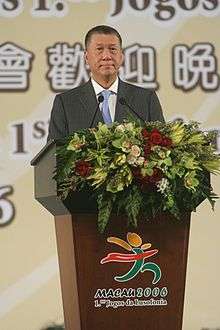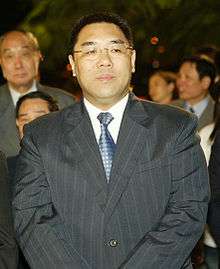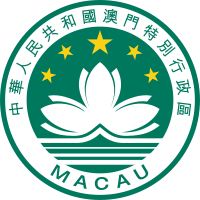Chief Executive of Macau
| Chief Executive of Macau Special Administrative Region 澳門特別行政區行政長官 Chefe do Executivo da Região Administrativa Especial de Macau | |
|---|---|
|
| |
| Style | The Honourable |
| Residence | Macau Government Headquarters |
| Nominator | Election Committee |
| Appointer | Premier, Central People's Government |
| Term length | Five years, renewable once |
| Inaugural holder |
Edmund Ho 20 December 1999 |
| Formation |
Macau Basic Law 20 December 1999 |
| Website | gce.gov.mo |
The Chief Executive of Macau (Chinese: 澳門行政長官; Portuguese: Chefe do Executivo de Macau) is the head of the government of Macau, a special administrative region of China and a former Portuguese overseas province governed by the Governor of Macau. Under the Basic Law of Macau, the CE's role is:
...be the head of the Macau Special Administrative Region and shall represent the Region. The Chief Executive of the Macau Special Administrative Region shall be accountable to the Central People's Government and the Macau Special Administrative Region in accordance with the provisions of this Law.
The current chief executive is Fernando Chui Sai On. His office is located at the Macau Government Headquarters, formerly the Governor's House (from 1883-1926) and the Governor's office (from 1926 to 1999). The CE has used this as his office since 2009.
Powers of the CE of Macau
The powers of the CE of Macau are outlined in the region's Basic Law:
- To lead the government of the Region;
- To be responsible for the implementation of this Law and other laws which, in accordance with this Law, apply in the Macau Special Administrative Region;
- To sign bills passed by the Legislative Council and to promulgate laws; To sign budgets passed by the Legislative Council and report the budgets and final accounts to the Central People's Government for the record;
- To decide on government policies and to issue executive orders;
- To formulate the administrative regulations and promulgate them for implementation;
- To nominate and to report to the Central People's Government for appointment the following principal officials: Secretaries of Departments, Commissioner against Corruptions, Director of Audit, the leading members of the Police and the customs and excise; and to recommend to the Central People's Government the removal of the above-mentioned officials;
- To appoint part of the members of the Legislative Council;
- To appoint or remove members of the Executive Council;
- To appoint or remove presidents and judges of the courts at all levels and procurators in accordance with legal procedures;
- To nominate and report to the Central People's Government for appointment of the Procurator-General and recommend to the Central People's Government the removal of the Procurator-General in accordance with legal procedures;
- To appoint or remove holders of public office in accordance with legal procedures;
- To implement the directives issued by the Central People's Government in respect of the relevant matters provided for in this Law;
- To conduct, on behalf of the Government of the Macau Special Administrative Region, external affairs and Other affairs as authorized by the Central Authorities;
- To approve the introduction of motions regarding revenues or expenditure to the Legislative Council;
- To decide, in the light of security and vital interests, whether government officials or other personnel in charge of government affairs should testify or give evidence before the Legislative Council or its committees;
- To confer medals and titles of honour of the Macau Special Administrative Region in accordance with law;
- To pardon persons convicted of criminal offences or commute their penalties in accordance with law; and
- To handle petitions and complaints.
History
The Office of the CE was created by the First Session of the Eighth National People's Congress of the People's Republic of China on 31 March 1993 and came into effect on 20 December 1999.
Election of the CE
The CE is selected by election or through consultations held locally and be appointed by the Central People's Government. The term of office of the Chief Executive shall be five years and may serve for not more than two consecutive terms.
Resignation
Under Section 54 of the Basic Law, the CE can resign if:
- When he or she loses the ability to discharge his or her duties as a result of serious illness or other reasons;
- When, after the Legislative Council is dissolved because he or she twice refuses to sign a bill passed by it, the new Legislative Council again passes by a two-thirds majority of all the members the original bill in dispute, but he or she still refuses to sign it within 30 days; and
- When, after the Legislative Council is dissolved because it refuses to pass a budget or any other bill concerning the overall interests of the Macau Special Administrative Region, the newly elected Legislative Council still refuses to pass the original bill in dispute.
Section 55 covers the temporary assignment of the role of the CE proceeding resignation.
List of Chief Executives of Macau
Politiical party: Nonpartisan
| № | Portrait | Name (Birth–Death) |
Term of office | Duration | Political affiliation | Term | Government (CoEx) |
Election | Ref | |
|---|---|---|---|---|---|---|---|---|---|---|
| 1 |  |
Edmund Ho Ho Hau Wah 何厚鏵 (b. 1955) |
20 December 1999 | 20 December 2004 | 10 years, 0 days | Nonpartisan (Pan-establishment) |
1 | Ho I (UPP) |
1999 | |
| 20 December 2004 | 20 December 2009 | 2 | Ho II (UPP • UIEM • UIPM • CCCAE) |
2004 | ||||||
| The first Chief Executive of Macau since the Handover of Macau from Portugal. Previously served in the Legislative Assembly of Macau as the Vice President. | ||||||||||
| 2 |  |
Fernando Chui Chui Sai On 崔世安 (b. 1957) |
20 December 2009 | 20 December 2014 | 6 years, 353 days | Nonpartisan (Pan-establishment) |
3 | Chui I (UPP • UIEM • UIPM • ACUM) |
2009 | |
| 20 December 2014 | Incumbent | 4 | Chui II (UPP • UIEM • UIPM • ACUM • UE) |
2014 | ||||||
| Served in the Legislative Assembly of Macau from 1992 until 1999. In 1999, Chui replace Antonio Salavessa da Costa and Alarcão Troni as the Secretary for Social Affairs and Culture of Macau | ||||||||||
Executive Council
See also
References
- Macao SAR Chief Executive Office Website
- Role of the Chief Executive - Basic Law of Macau
- Biography of the CE of Macau

